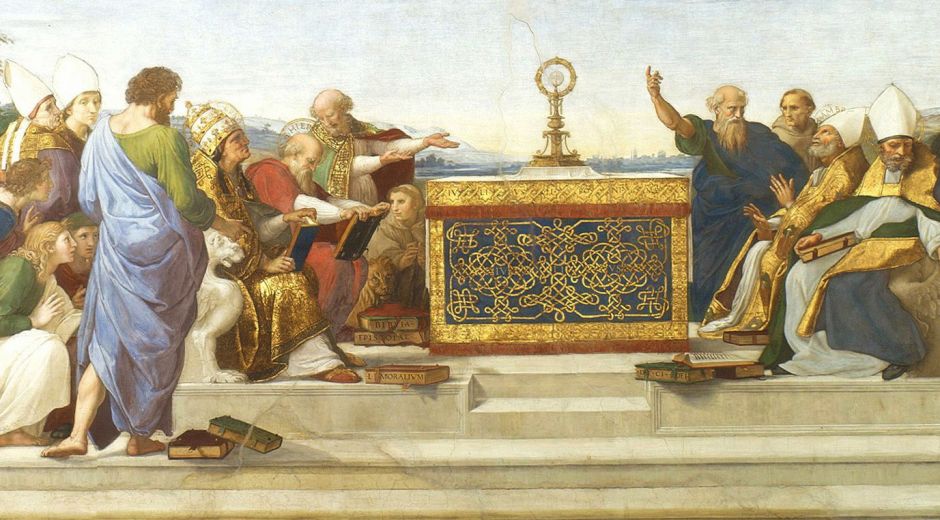Just as the young Raphael was developing his mature style of painting in 1508, he was summoned by Pope Julius II to paint for him in Rome. This was the career move which transformed Raphael’s personal aspirations into a revolution in European painting.
His initial commission for the Pope is now among the most revered of all Raphael’s works: the first of what became a series of painted rooms intended to become the Pope’s private library within the Vatican Palace, which soon became known as his stanze (plural of stanza, meaning simply room), or the Raphael Rooms. He probably started on these in early 1509, completing the Stanza della Segnatura (‘room of the signature’) by the end of 1511.
In this article, I show his three major paintings on the walls of the Stanza della Segnatura. These are accompanied by numerous smaller works which cover the ceiling and other parts of the walls. The overall effect is of being inside one large enveloping work of art. Although many commentators have remarked on the impression given that each of these paintings was spontaneous, Raphael was meticulous in his preparations, making many drawings before climbing the scaffold and applying paint to wet plaster.

Traditionally, the first to be considered is the Disputa, or Disputation of Holy Sacrament, which may have been the first to be completed in the period 1509-10. This doesn’t represent what we know as a dispute, but a theological discussion on this aspect of the Christian faith. Its apex contains the Holy Trinity of God the Father (top), Jesus Christ flanked by the Virgin Mary and Saint John the Baptist, with the white dove of the Holy Spirit below.
The tier with Christ at its centre represents the elect, a group of the most revered saints, and figures from the Old Testament including Adam, David, Abraham, Moses and possibly Joshua.

The lower tier is earthly, centred on an altar and simple monstrance containing the Holy Sacrament. Seated beside that are the Roman Fathers of the Church, including Gregory, Jerome, Augustine and Ambrose. In the flanks are many other figures who were important to the church at the time. Notable among these is Dante, seen in profile mid-right, with a laurel wreath on his head and red robes.

Raphael probably completed the second, The School of Athens, over the same period of about 1509-10. It was first recognised as depicting eminent Greek philosophers in 1695, although Vasari’s account in his biography of Raphael assumed that it included a group of evangelists, and others have claimed that the figures are taken from Dante’s Divine Comedy.
An assorted collection of Greek philosophers, together with a few extras, are chatting, teaching, and generally loafing about in an impressive building of grand classical style which is probably Raphael’s extended fantasy based on the contemporary architecture of Bramante. Although there’s no coherent narrative to this painting, it contains numerous diverting scenes in which the viewer is challenged to recognise the participants.
The central figures are Plato (left), who carries in his left hand a book titled TIMEO, and Aristotle (right), whose book bears the word ETICA. Seen further to the left in profile is Socrates, and below him is Pythagoras, who is writing in a book while a boy holds in front of him a small blackboard showing the theory of harmony.

His opposite number on the right is Euclid, who is bent over and holding a pair of compasses in his right hand. Behind him are Ptolemy, who is holding a globe and facing away, and Zoroaster, who holds a celestial sphere with his right hand. One striking figure for which I haven’t seen any plausible identification is the woman behind Pythagoras, who appears to have walked out of Leonardo da Vinci’s Mona Lisa.
As with the Disputa, several commentators have drawn attention to this anachronistic assembly, in that some of these figures lived centuries apart. Not only is Renaissance thought not as inflexible as that, but Raphael’s intent wasn’t realistic depiction of any hypothetical event, of course.

Parnassus may have been the last of these three frescoes to have been completed, by 1511 according to an inscription below the window. At its centre is the god Apollo, who is bowing a string instrument and looking upward for inspiration. Surrounding him are the full set of nine Muses, who mostly defy individual identification.

On the left flank of the rocky hillock are poets, including Homer, Dante, Virgil and possibly Statius, whose departure from Purgatory is recorded by Dante. Below them, the woman leaning out of the false frame of the painting is Sappho, and that group of men probably includes Petrarch. Other identifications are disputed, as is the suggestion that these poets are divided into epic, lyric and dramatic groups. Again, there are no grounds for claiming anachronism, in that these poets’ lives spanned a period of more than two millenia.
The ceiling has the theme of justice or jurisprudence, and the walls theology (the Disputa), philosophy (the School of Athens), and arts or poetry (Parnassus), which are represented in painted medallions. These are only appropriate for a library, and would have been approved by the Pope himself.
In these remarkable frescoes, Raphael excels at every level. Each figure is formed individually, and brought to life. The figures are assembled into a harmonious composition in which they become but a part of the whole. Each painting in turn develops its theme cohesively, and in partnership with the other paintings. As a work of art, the Stanza della Segnatura comes as close to perfection as man can attain.
This was only the start of his monumental frescoes in their stanze.

